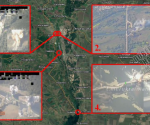Half a million Germans dead by the RAF (and friend) is evidence of 50,000 Britons dead by the British Army (Series finale, Part A)
In the closing chapter of his book, Secret Casualties of World War Two, Simon Webb presents a range of between 5,000 and 50,000 for the number of British civilians killed by their supposed own side – i.e. by anti-aircraft artillery – over the six year period. Unless this author missed it, Webb doesn’t offer a definitive number, but it appears he probably thinks that 26,000 dead would be a probable figure because of how he proffers it at the beginning and at the end of his book as a reasonable estimate.
Holding Churchill ultimately responsible for these unnecessary deaths (and, in his way, for the deaths caused in general during German bombing of London, especially), and what he terms a massacre, Webb recognises that the acts whereby these deaths occurred were crimes. This author doesn’t disagree, but doesn’t hold Churchill solely responsible, because that criminal, although he might have been involved in decision making somewhere at the top of the Masonic military intelligence-City of London amalgam hierarchy that ruled the UK back then as it does now, he was above all else a figure head appointed for his warmongering reputation, so that the decision making as it appeared to be coming from a republican government in name, when it looked unscrupulous and monstrous, and as if it didn’t care about the wasted life it would create, could look plausible, and in the pattern of Churchill’s oafish and blood-lustful previous. Moreover, he was appointed as a reflection of the disaster that had befallen the UK Government in 1940, its consequent desperation, and the need to motivate the British people into persevering as victims in a war that wasn’t of their making, against an enemy that all too evidently didn’t want to fight (or else, the “Phoney war” would not have been so called), and above all else had already been lost.
Being mostly conventional other than drawing attention to facts (which court historians won’t go near) that damage UK Government and Britain’s post-war reputation as reluctant killer in the prosecution of a war that had to be fought, it is conceivable that Webb, although he understands the mendacity of the war-time UK Government to a point, wouldn’t be able to make a realistic appraisal of how many British citizens were “democided” under cover of German bombing. Anyone who doesn’t understand that the UK Government acted out of finding itself in a disaster of its own making, after German conquest of France, to keep the British people invested in a conflict, and then acted out of the need to accomplish the original goals it had devised in engineering the war – i.e. to devastate Germany (done by RAF bombing instead of a quagmire war in central and eastern Europe, as had been envisioned) – won’t be able to appreciate the HG Wells’ Martian alien mentality of UK Government. Additionally, if we consider that the RAF killed tens of thousands of Germans in terror-bombing in deliberate targeting (to see how German wooden medieval cities would burn)†, one draws a conclusion that as far as mutual treatment was concerned, it was the UK Government, not the Nazi German one, that didn’t care about human cost on the way to getting what it must have.
The reader will have to look elsewhere for what are called revisionist histories that now begin to reveal the high criminality of UK Government in its destruction of Germany, which all too evidently was covered up by the act of rebranding German slave labour camps (no less evil places, but where deaths were as a consequence of the internment) as deliberate extermination camps through cunning propaganda and having post-war war crime trials devoted to the prosecution of high profile German leadership, but Webb does touch on the subject. Surprisingly, his main focus is on the deliberate targeting of civilians, not in Germany, but in occupied France, and the complete razing to the ground of one town in particular.
Conventionally, the end of the Blitz is ascribed to Hitler giving up on invading Britain – but this is nonsense. There is no way, with the Royal Navy in the waters between France and England, that Germany could ever have staged an invasion of Britain – especially in those horse-towed canal and river barges that British historians say were being collected at the Channel coast to serve as troop transporters.
In reality, it would appear that Germany changed her approach to bring the UK Government to the peace table with besiegement by naval warfare in the Atlantic. Of course, it can’t be denied that other things were happening in the east, but it cannot be realistic to say, as is the impression one gets regarding court (TV-tells-therefore-audience-knows-style) history, that the invasion of Russia was somehow a fall back plan after a “failure” against Britain.
In fact, it’s no accident that the pattern of German bombing changed even as the “Blitz” was winding down. The following is from Wikipedia’s page on “The Blitz”:
In 1941, the Luftwaffe shifted strategy again. Erich Raeder—commander-in-chief of the Kriegsmarine—had long argued the Luftwaffe should support the German submarine force (U-Bootwaffe) in the Battle of the Atlantic by attacking shipping in the Atlantic Ocean and attacking British ports. Eventually, he convinced Hitler of the need to attack British port facilities. At Raeder’s prompting, Hitler correctly noted that the greatest damage to the British war economy had been done through the destruction of merchant shipping by submarines and air attacks by small numbers of Focke-Wulf Fw 200 naval aircraft and ordered the German air arm to focus its efforts against British convoys. This meant that British coastal centres and shipping at sea west of Ireland were the prime targets.
Hitler’s interest in this strategy forced Göring and Jeschonnek to review the air war against Britain in January 1941. This led to Göring and Jeschonnek agreeing to Hitler’s Directive 23, Directions for operations against the British War Economy, which was published on 6 February 1941 and gave aerial interdiction of British imports by sea top priority. This strategy had been recognised before the war, but Operation Eagle Attack and the following Battle of Britain had got in the way of striking at Britain’s sea communications and diverted German air strength to the campaign against the RAF and its supporting structures.
What this says at the end is that Germany’s strategy had always been siege by sea, with the Luftwaffe in support, but the need to deal with the RAF (not to prepare for an invasion, but to stymie its capability to conduct operations in Europe – as has been discovered before in this series) delayed the implementation.
Furthermore, when Webb tells of the razing of the ground of the French Atlantic coast town of Saint-Nazaire, he is unwittingly telling of an event in the real campaign that Germany was wanting to wage – not directly against British civilians – but against British shipping. Saint-Nazaire was bombed by the RAF from the start of German occupation, and then by the American army air force, which led ultimately to the entire population being evacuated. The target, we are told, was submarine pens, which were so well built that they survived all the bombing. In fact, one concludes (and we’ll probably find this to be true if we looked it up) that the act of razing the city to the ground was due to a long understanding had by British military that the naval facilities were unassailable, and so the objective would be to make them unserviceable by stripping the civilian centre away from them. This would be like the Germans rendering Newcastle to rubble because of its ship building. Of course, as we know, Newcastle’s Regency town centre survived to us through the war intact.
So here we have the contrast in a nutshell which tells of Germany doing only what was necessary, and Britain deliberately causing bloody mayhem. Indeed, the complete picture tells of the real savage berserker nature of UK Government, who as well as employing its own armed services to smash Germany and kill as many Germans as possible, essentially compounded its evil by directing the might of the American military to do the same when it became available.
Of course, the introduction of the Americans into the story allows us to look at a remarkable coincidence: in the years after 1941, when in November of that year, the USA entered the war (as UK Government had pinned its survival on), casualties in Britain occurring from German air raids fell dramatically. As we will see, this had as much to do with the objectives of UK Government as it has to do with German capability or intent – and this will be the subject matter for a sub-part (part B) of this article to come next. In other words, we will consider evidence for high numbers of British civilian casualties through “friendly fire” by looking at change of behaviour of UK Government in terms of defence of the skies from German attack. Again, this isn’t as simply a matter of the Germans being more incapable of raising enough arms against Britain as the war went on. It involves the UK Government’s objectives changing from rabble rousing citizens by provoking the Germans into bombing them, and dropping shells on them on top of that, to protecting itself; in particular, the way that UK Government reacted to German rocket bombing, which was intended to strike at the heart of UK Government itself.
As far as this piece goes, it has been an attempt to understand that UK Government would have been capable of causing the highest number of artillery shell death that we can imagine because of its attitude to German and even French citizenry. What with the Martian alchemical cleanser-by-fire clearly in its nature, combined with the opportunity to live up to expectations for that capability, it suggests that the number of British civilians killed by UK Government should be suspected as being as high as possible in the range that Webb supplies. In short, it would be no surprise if direct British civilian death by UK Government under the cover of German bombing was closer to 50,000 than it was to 26,000. Don’t forget, it was the objective of the UK Government to impress upon British people that they too were combatants in a war that had to be won because of the evil of the other side. What better way for UK Government to do this than kill and maim the population of its governed, and blame it on the Nazis, and what better way to make this convincing than kill and maim as many people as possible.
† Berlin is just one city that got attacked. Wikipedia has a page on the “Battle of Berlin” regarding RAF bombing of the city from November 1943 to March 1944. The criminal, Arthur “Bomber” Harris actually said this: “We can wreck Berlin from end to end if the USAAF come in with us. It will cost us between 400 and 500 aircraft. It will cost Germany the war”.
In 1982, reports the Wikipedia page, a historian wrote that in this campaign of bombing, “7,480 people had been killed, 2,194 people were reported missing, 17,092 were injured and 817,730 Berliners made homeless”. In 2003, another wrote that “nearly 4,000 people were killed, 10,000 injured and 450,000 made homeless”. The problem that we’re dealing with is obvious. The myth installed after the war of British do-goodedness enables systematic downgrading of the crime committed by the criminal RAF crews and the people who sent them to do murder.
Of course, Dresden is the infamous case of the genocide carried out by UK Government against the Germans: Wikipedia estimates 22,700 to 25,000 dead in four raids in February 1945. However, there were many others: over one hundred towns and cities bombed, and these are examples (with the figures and quotes being gleaned from Wikipedia): Wuppertal (6,500 dead, “38 percent of the built-up urban area was destroyed”), Hamburg (37,000 dead, “61% of the housing stock was destroyed or damaged”), Remscheid (“ almost completely destroyed” [in one night]), Kassel (at least 10,000 dead, “ the vast majority of the city center was destroyed”), Braunschweig(“90% [of ‘downtown’ area destroyed, and the overall figure… 42%”), Kaiserslautern (“bombing destroyed more than 85%), Saarbrucken (“75 percent of the city left in ruins”), Darmstadt (at least 4,000 dead. “The destruction of dwellings in… [centre and… districts immediately to the south and east]… was almost complete), Stuttgart (at least 4562 dead, “68% of… center was destroyed), Heilbron (7,000 dead), Ulm (“81 percent of the city center was destroyed), Pforzheim (17,600 dead, “83 per cent of the… built-up area was destroyed”), Mainz (“80 percent…destroyed”), Wurzburg (5,000 dead in one 20 minute raid in March 1945, “ Almost 90% of the buildings were destroyed” and Hildeshelm (in one raid in March 1945, “74% of the buildings… were destroyed or damaged”) were also cities that were incinerated by British – and also American – bombing.
One finds a pattern of at least one thousand people killed in every place attacked, so a Wikipedia page on German casualties in World War II sounds right when it says this: “Estimates of German civilians killed only by Allied strategic bombing have ranged from around 350,000 to 500,000”. That’s half a million people, reader, most likely incinerated in RAF-created firestorms. And, in fact, this is probably only the half of it given the fact that the reputation of the saviours of the world from Nazism is at stake.
Harris used to talk about the Germans sowing the wind and reaping of the whirlwind, but in reality, if you are British, reader, your grandparents and great-grandparents, when they did the opposite of what they needed to do in 1940 when UK Government was at the weakest it has probably ever been, sowed the real wind.


















